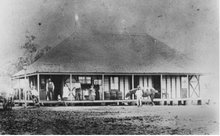 Queenslanders (the houses) are built for coolness. Windows are located to facilitate cross ventilation. Outside walls are double-skinned with timber or weatherboard cladding and vertical joists (vjs) inside. Internal walls are often single-skinned vjs. Floorboards are laid directly on the house’s structural joists. Houses are raised off the ground from low-set ones that you can just crawl under to high-set, that you can enclose for a first storey or park your car under. Louvered windows are common. Breeziness is the key.
Queenslanders (the houses) are built for coolness. Windows are located to facilitate cross ventilation. Outside walls are double-skinned with timber or weatherboard cladding and vertical joists (vjs) inside. Internal walls are often single-skinned vjs. Floorboards are laid directly on the house’s structural joists. Houses are raised off the ground from low-set ones that you can just crawl under to high-set, that you can enclose for a first storey or park your car under. Louvered windows are common. Breeziness is the key.So when cold weather comes, our traditional houses are spectacularly unsuitable. In our case, the front veranda has been enclosed to form a sunroom. You can look through cracks between the boards of the (gorgeous) hardwood floor to the ground below. When cold winds blow, you can feel the breeze whistling around you. On Friday when I was working on the computer, I had to frequently stop to sit on my hands to warm them.
On the few cold days of the year, you have a couple of options. You can go modern with reverse cycle airconditioning. You can go traditional with a cast iron wood heater and shutting up the house. Or you can just put on more clothes. We have a modern wood burning stove that heats up the house nicely when we shut all the windows and close the veranda doors. I calculate that the pollution caused by burning wood is minimal given how rarely we use it. We also don’t have an airconditioner so perhaps we are entitled to a little leeway on the carbon front.
 The chill in my extremities this weekend made me think about how it would have been for early settlers in their slab huts. Basically building a slab hut meant cutting down a tree, slicing it into boards, then putting these boards, often still with bark attached, onto a frame. High-end models had tin roofs, many just used bark. Many people had small cast iron wood stoves but others relied on open fires. House fires and burns were common.
The chill in my extremities this weekend made me think about how it would have been for early settlers in their slab huts. Basically building a slab hut meant cutting down a tree, slicing it into boards, then putting these boards, often still with bark attached, onto a frame. High-end models had tin roofs, many just used bark. Many people had small cast iron wood stoves but others relied on open fires. House fires and burns were common.When we were looking at properties in this area, we were shown a house on the Bluff overlooking Ashwell that had what the agent grandly called “a building of some historical significance” on its land. This building was a tiny settler hut. It wasn’t much larger than a few square metres, perhaps three metres by two. It was set off the ground on stumps with a few simple steps leading up to the door. Inside it was divided into two rooms with a miniscule cast iron stove. I couldn’t even imagine it as being large enough to use as guest quarters and yet it was a home. In many of the family history books, mention is made that as soon as people could, they replaced their slab hut with a more substantial dwelling. In weather like we have had, I can understand their hurry.
*The pictures are from the State Library of Queensland archives and are free of copyright.

No comments:
Post a Comment